Everything you need to know about how to install a carpet runner
If you’ve ever wondered, “can I use a carpet runner on stairs?”, the answer is YES, you absolutely can!
Installing a carpet runner on your stairs is not only a beautiful upgrade but a practical one too! Today, I’ll be sharing how to add a diy stair runner to your staircase.
Carpet runners on stairs help to protect your home’s flooring from wear and damage from heavy traffic, as well as from cleaning and exposure to the elements.
This is one DIY project that I ma so glad I did. Not only has it added style but warmth and comfort too! So if you’re in the market to Install a carpet runner on your staircase, or to upgrade an old runner and add a new carpet, read on!
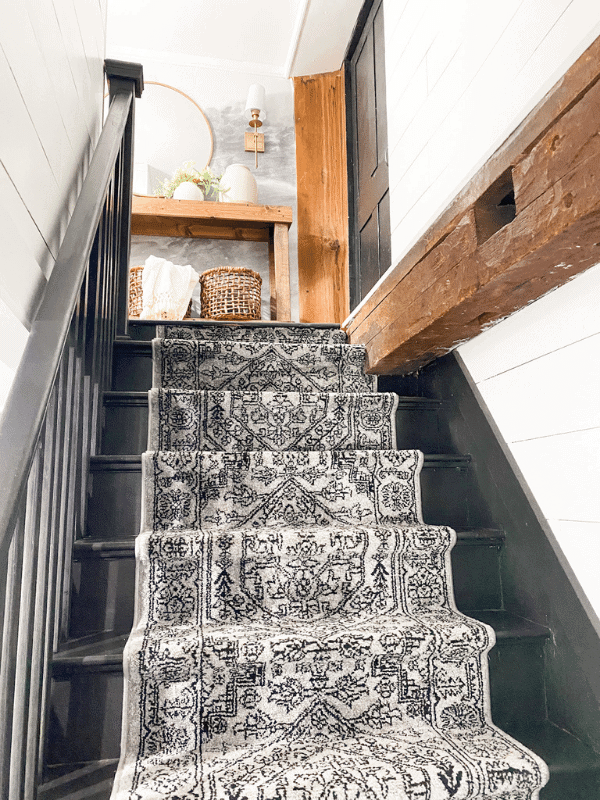
Can I install a carpet runner myself?
Yes, you definitely can! Installing stair carpet runners are a moderately simple project, which can be easily DIY’d in one day without a lot of specialized tools.
Do I have to use a tackless strip to install a carpet runner to my stairs?
The short answer is no, you don’t have to. Tack strips are thin pieces of wood with hundreds of sharp nails or tacks used in the installation of carpet.
They help to hold down heavy carpets so they don’t pull up over time. This is especially important when you are installing wall to wall carpet.
Installing a carpet runner is a different story. Runners are thinner and narrower then the carpet you would install for wall-to-wall carpeting. Rug tape, a staples gun and carpet tacks are sufficient enough to hold down your runner.
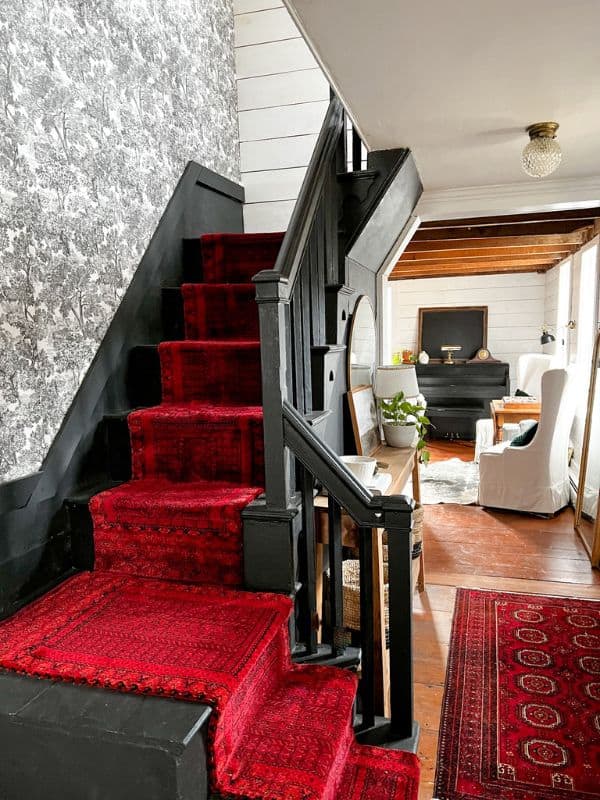
Can I use an outdoor rug on my stairs?
Yes, You can use any kind of carpet on your stairs. Choosing a runner for your stairs has more to do with the material of the runner rather than if its meant for outdoor or indoor use.
What material is best on stairs?
When choosing a stair runner, its best to choose a runner that is either a synthetic nylon carpet or wool. Wool can be quite expensive though. Runners made from synthetic fibers are very durable and stain resistant.
They can also have a bit of a stretch too. Really you don’t want a runner that has too loose a weave or too high pile. The loose weave will come undone more easily and the high pile can make it dangerous to walk on. Your foot could get caught and you could take a fall.
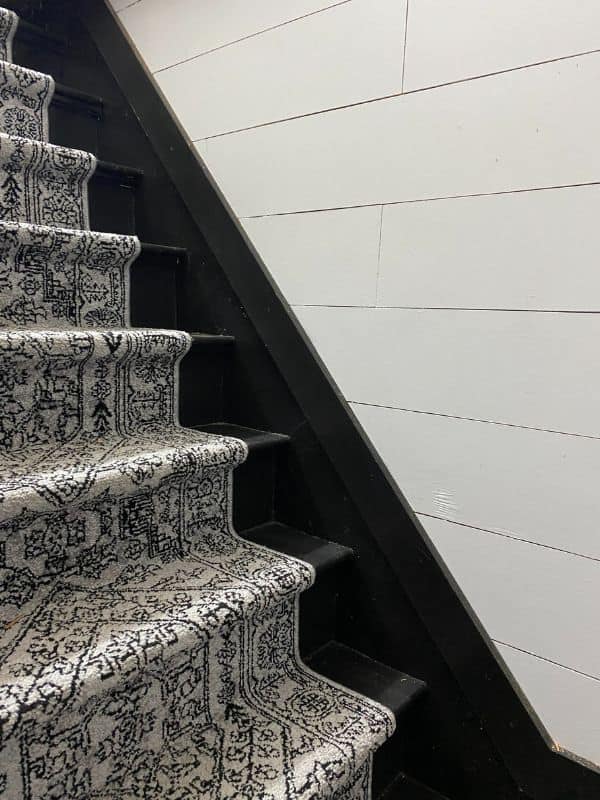
How to install a stair runner without nails
The easiest way to install a stair runner without the use of nails is to use a heavy-duty staple gun instead.
If you opt not to use any hardware, be sure to use a high-quality carpet tape and carpet pad that grips strongly to the surface of the stairs.
This can also be done if you’d like to install the carpet runner without damaging hardwood!
Do I use staples or carpet tacks to secure my stair runner?
You can use either or both. I prefer using both because I like the finished look of carpet tacks and I like the quick insulation with a staple gun.
I place the carpet nails along finished edge of the side of the runner. This keeps everything is place and looks stylish.
Although, sometimes a staple gun isn’t bring enough to penetrate hardwood stairs. If this is the case for you, you’ll have to use carpet nails.
What size staples to use for carpet runner instalation?
I find it best to use 1/2 staples when installing a carpet runner. This way at least 3/16 – 1/4 inch will penetrate and secure the carpet to the stairs. Otherwise, if not enough of the staple penetrates, you run the risk of the staples popping out.
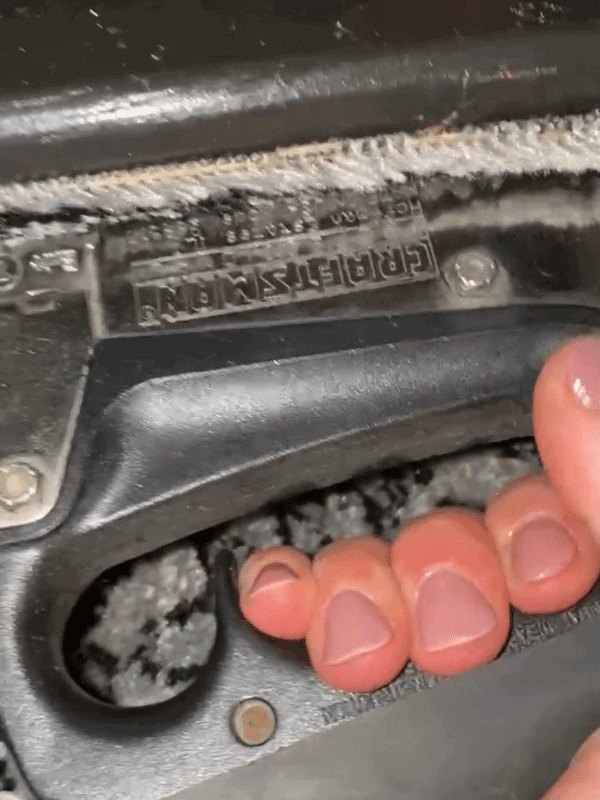
How to accurately map out the placement of your stair runner?
I find it best to use painter’s tape to accurately map out where my carpet runner will be placed on my staircase. This way you aren’t chancing that you are hitting dead center as you are installing your carpet.
Start by measuring the width of the bottom tread. Next, divide that number by two. This will be the center of the staircase.
Take that number and measure from one side of the staircase to the center. Mark that spot with painter’s tape. Then measure the stair runner itself and divide that number by two.
Take that number and measure from the center of the stairs (from the painter tape) to the outer edges in each direction, marking each spot with painters tape.
Repeat this process on each step all the way to the top the step at the top of the staircase. Now you can visually see where your carpet needs to be placed while installing it.
How to measure your staircase and select your new stair runner
One of the first things to do is figure out the measurement of the runner you need before you buy one. To start, grab your tape measure and measure the depth of the tread and the height of the riser.
Multiply the height by the number of stairs (risers), and the depth by the number of treads. Add these figures together, plus six inches for waste. It’s better to have excess carpet then not enough! This is the total length you’ll need to order.
The width of the runner is up to you, but stair runners look best when there is about 4-6 inches of the exposed riser on either side. Start by measuring the from one edge of the tread to the other.
Then minus about 8 inches from that number. You can use that number as a starting place while shopping for carpet runners. Once you choose a runner, consider the width when ordering the correct size carpet padding.
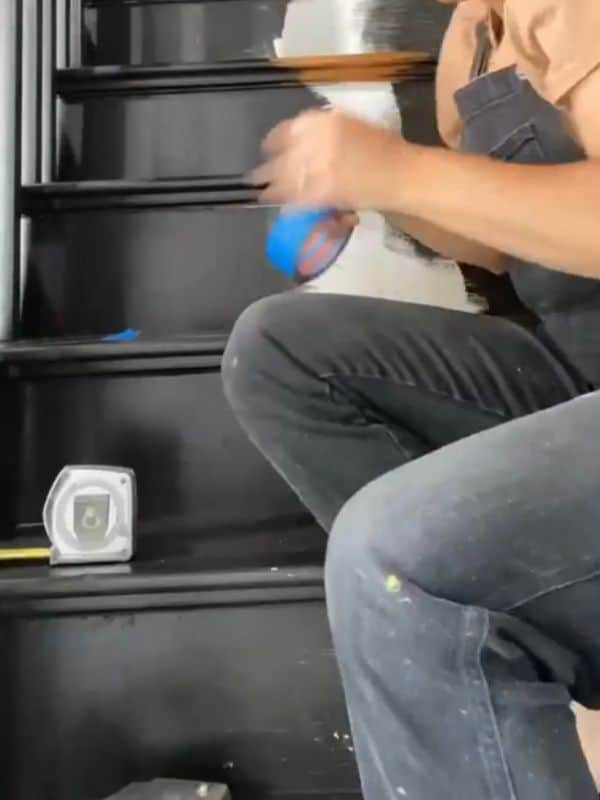
Do carpet runners need padding?
Unless you choose a runner with a non-slip backing, you will need to use carpet padding. Ideally, carpet padding should be used under any rug that is at risk of sliding around.
Without carpet padding, stair runners are at risk of slipping out of place and lead to dangerous slips and falls. It can also work to protects the the stairs overall from normal wear and tear.You can either buy tread pads in the correct measurement or cut your own.
How to install carpet pads
If you bought treat pads cut to the correct size, then you can begin by placing each pad in the center od each tread and stapling in place. If you beed to cut your own carpet pads, start by measuring the carpet runner you intend to install.
Next, cut one pad to be the width of the runner minus 1 inch, and the depth of the stair tread minus ½ inch. Use this pad as a guide to cut as many as you will need for each stair tread.
Using a measuring tape for accuracy or the painters tape from the guide mentioned above, center and place the pad on the bottom tread. Leave a space about the width of one fingertip between the pad and the back of the riser.
Drive one staple into the center of the pad, then evenly place two more staples on either side. Repeat this process on each stair tread.
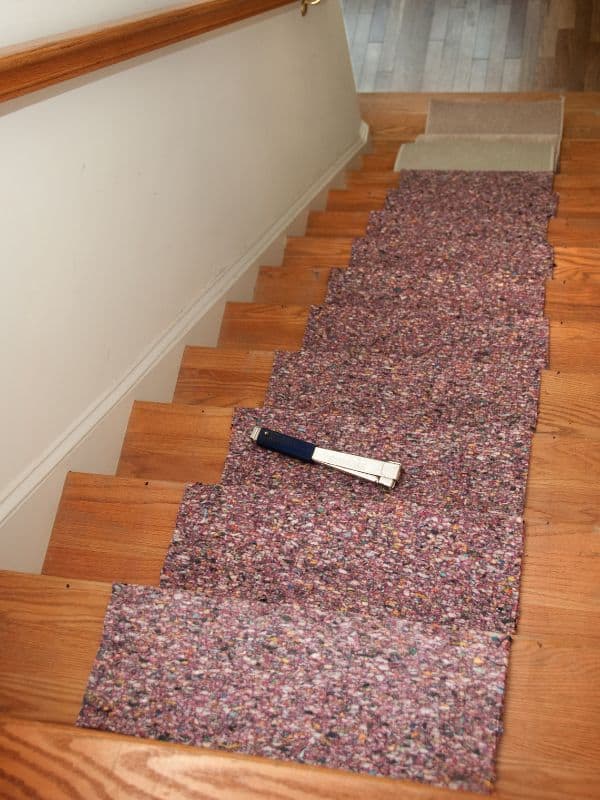
What installation style is best while installing a carpet runner on your stairs?
There are a few methods you can use when installing a carpet runner on your staircase. You can use double sided carpet tape, carpet adhesive, staples, carpet nails, tack strip, or stair rods. Today I’ll be using double sides carpet tape and a 1/2 inch staples.
How are carpet runners installed?
To install a carpet runner on your stairs you’ll first need to gather your supplies.
Tools Required:
- Carpet runner
- Rug pad *optional
- Double-sided carpet tape
- Carpet tucker
- Carpet knife
- Carpet scissors
- Staple gun and staples
- Measuring tape
- Bolster chisel
Step one: Apply the double sided carpet tape
Begin by cutting a strip of double-sided carpet tape, slightly shorter than the width of the carpet runner.
Starting at the bottom of the stairs, place the tape under the bottom step, along the bottom riser. Depending on the height of that riser, you may need to use two pieces.
One at the top of the riser and one at the bottom. Place another piece in the middle of the tread. Next, take the bottom edge of the runner and press it firmly to the tape on the bottom riser and over the tread.
I like to cut off the binding and use a lighter to seal the edge. But this isn’t necessary.
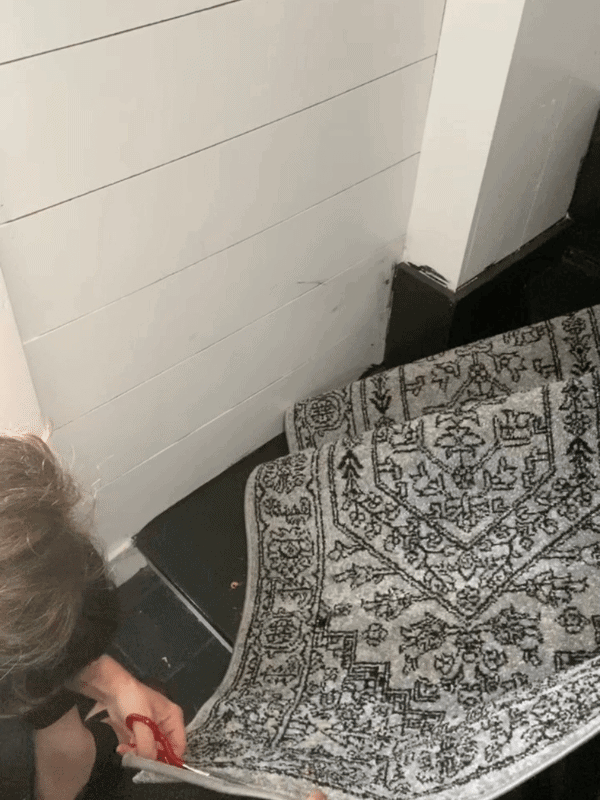
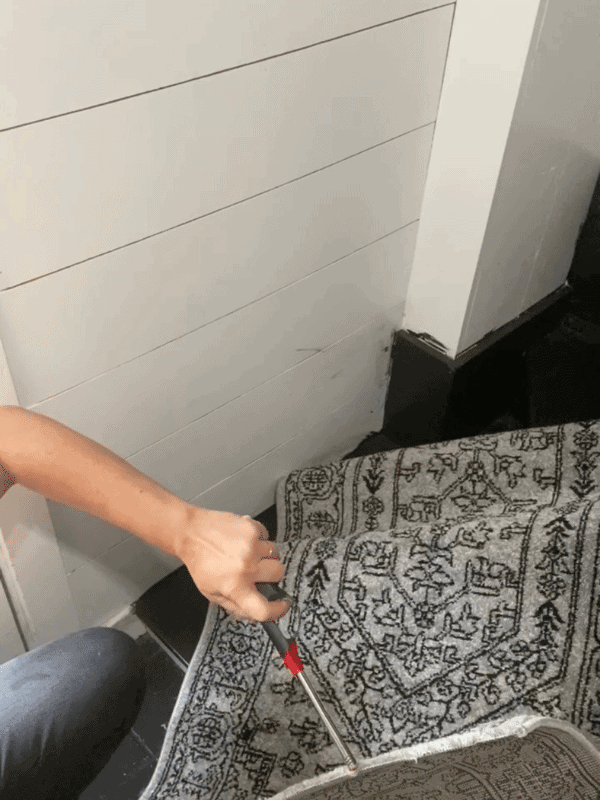
Step one: Apply the double sided carpet tape
Begin by cutting a strip of double-sided carpet tape, slightly shorter than the width of the carpet runner. Starting at the bottom of the stairs, place the tape under the bottom step, along the bottom riser. Depending on the height of that riser, you may need to use two pieces. One at the top of the riser and one at the bottom. Place another piece in the middle of the tread. Next, take the bottom edge of the runner and press it firmly to the tape on the bottom riser and over the tread. I like to cut off the binding and use a lighter to seal the edge. But this isn’t necessary.
Step two: Secure with staple gun
Once the runner is attached to the tape, use your staple gun to drive your first staple into the center of the edge of the rug at the top of the bottom riser, and another every three inches from the center on either side. Next, add another piece of carpet tape to the center of the tread and the next riser. Continue to secure your carpet in place by pressing the carpet over the tape.
Step three: Tuck and chisel
Once the carpet is smoothed over the tread of the next step, press your carpet tucker into the crease where the base of the riser and tread and tread meet. This will create a nice clean line. Lastly, press the bolster chisel into the top of the riser (under the nose) and into underside of the next tread. Securing it in place with a row of staples. Or if you don’t want to use a chisel, you can use the waterfall method instead.
What is the waterfall method in carpet installation?
The waterfall method refers to allowing the carpet to “fall” over the edge of the riser and down to the next without it being securely fitted around the riser. Otherwise, you would use a chisel under the nose of the stair tread to mould the carpet to the tread.
Step four: Repeat process
Continue with the method above by going one stair tread at a time, using the same pattern as mentioned before. Lay down your carpet tape and press your carpet runner inlace, tuck your carpet in the crease of the bottom of the riser and again at the top, using a chisel, and then run a line of staples at the top of each riser.
Repeat the process until you’ve reached the top of the stairs.
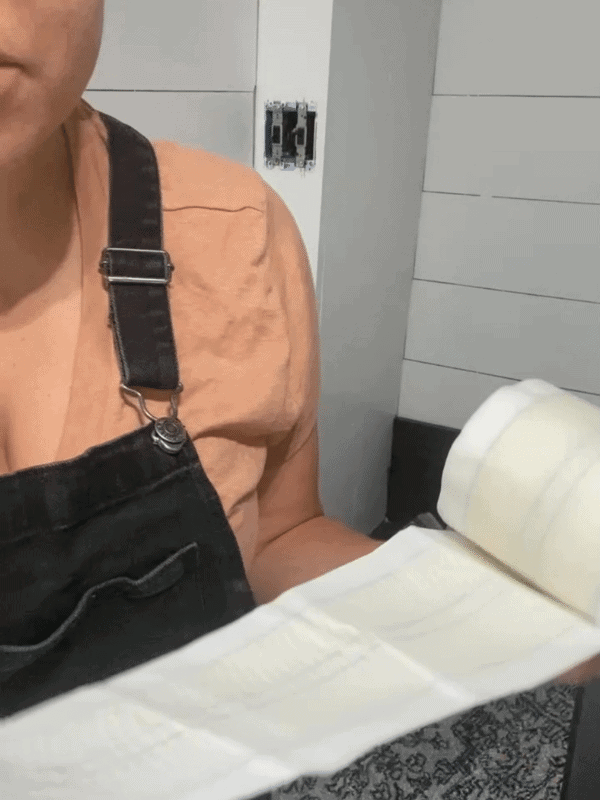
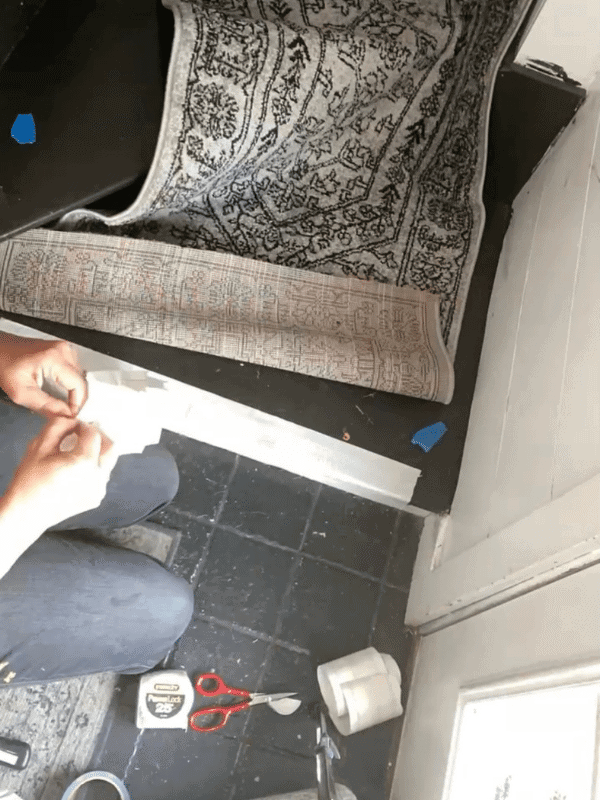
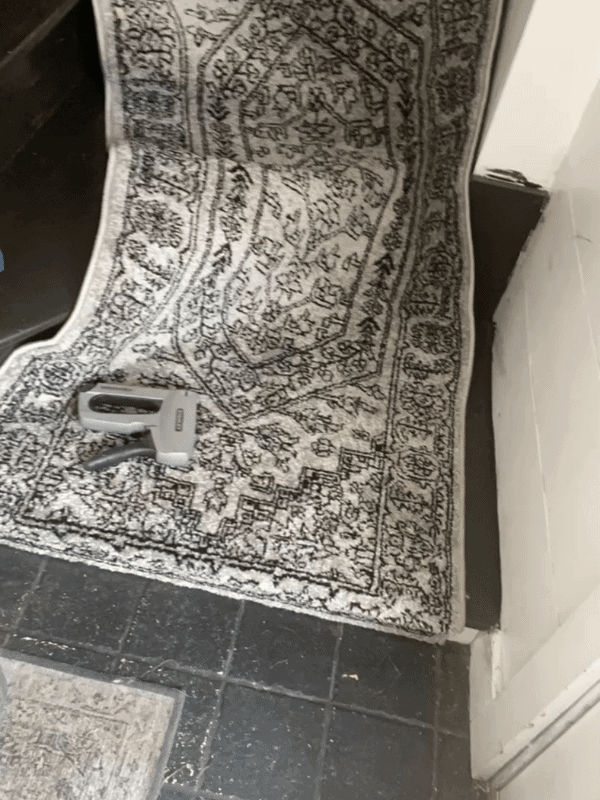
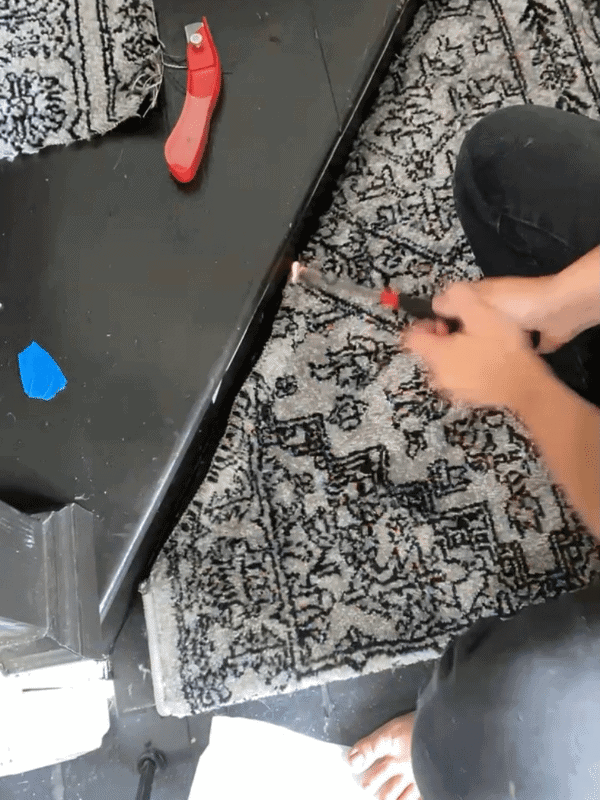
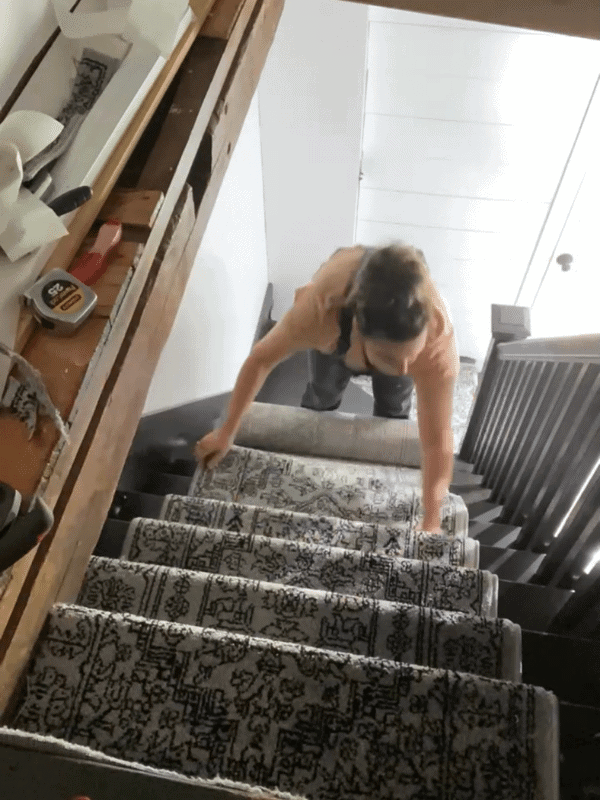
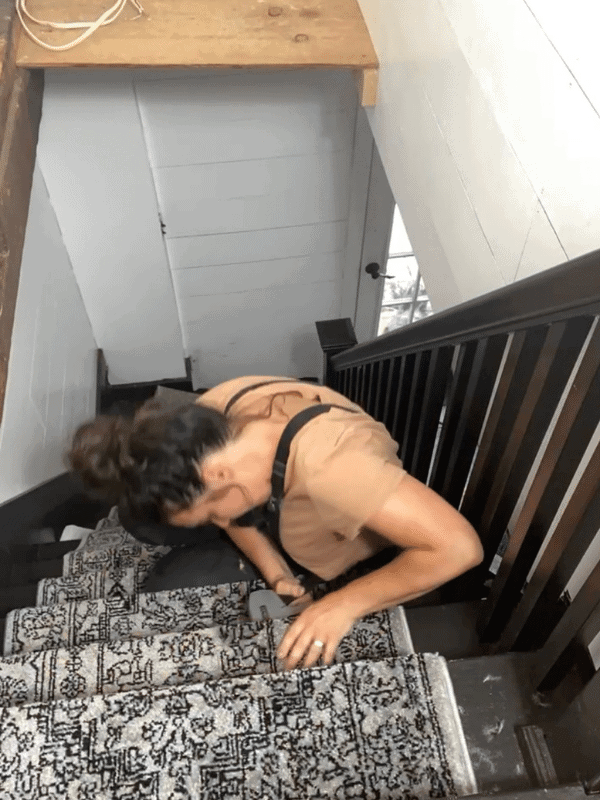
Step five: Finish installing the carpet runner
Once you reach the top riser, the last step is to use your utility knife to cut off any excess material at the end of the runner, then staple it into place. This will create a straight line and give your new runner a clean look.
If you’d like to see another example of how to instal a Capet runner check out HGTV’s!
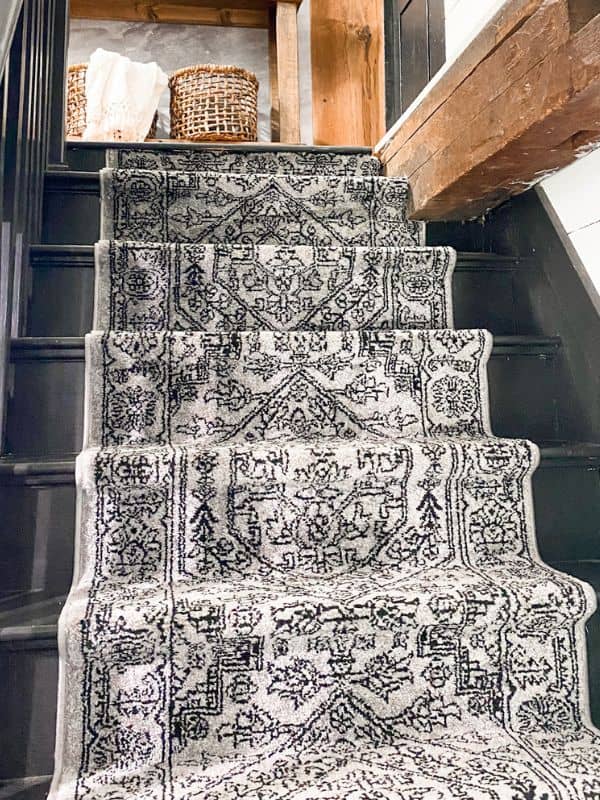
Need help picking out a runner for your staircase? Check out this post I’ve written 12 on classic stair runners and where to buy them.
How to install carpet runner on basement stairs
When installing stair runners on basement stairs, it’s very important to use carpet padding that will grip the surface well.
Some basement stairs are made of materials such as concrete or raw wood or may have a slippery, painted surface.
In this case, nails or staples may not be an option, and normal floor tape and carpet padding may not be effective. You may have to use a carpet pad with heavy-duty rubberized backing in order to hold the runner in place.
Another option to give the runner extra stability is to install stair rods once the runner is in place. Stair rods are typically slim, metallic tubes that are attached to brackets.
They lie on either end of the stair runner, and are installed on each individual stair.
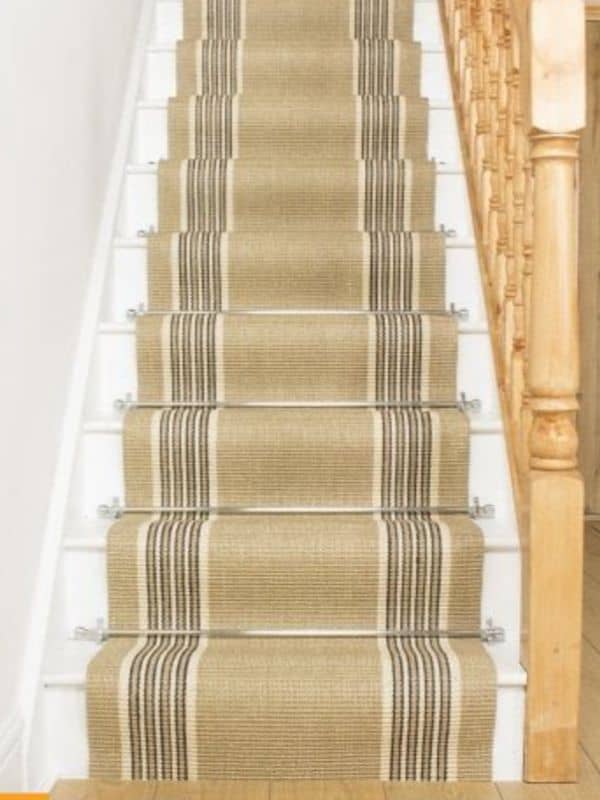
How to install a stair runner with rods
Tools Required:
- Carpet rods and brackets
- Rotary drill
- 1/16 drill bit
- Pencil
First, install the brackets by lining one against either edge of the runner, and sliding them back until they are sitting in the crease at the bottom of the riser (where the riser and the tread meet). Be sure they are aligned flush with the runner as well as the crease!
Holding the brackets in place, mark the location for the drill holes with a pencil, then use a 1/16 inch drill bit to create a pilot hole at each mark. Secure the brackets in place, at the back of the tread, by using the included hardware.
Next, press the rods over the carpet into the crease of the stair. Secure the rod into each bracket, and repeat until they are all secured. Home Depot has a great tutorial on installing carpet rods. Be sure to check it out to see a more step by step tutorial.
Be sure to to pin for later

Want to shop carpet runners and supplies for this project? Just click on an image below! *These links are affiliates. If used I make a small commission at no cost to you. Thanks for supporting the brands that support this blog of mine!
Want to read more about updating your home on a budget? Check out the article below!
Thanks for reading,
Chat soon,
Kori


I really like the rug runner on your stairs. Can you tell me what it is called and where you bought it?